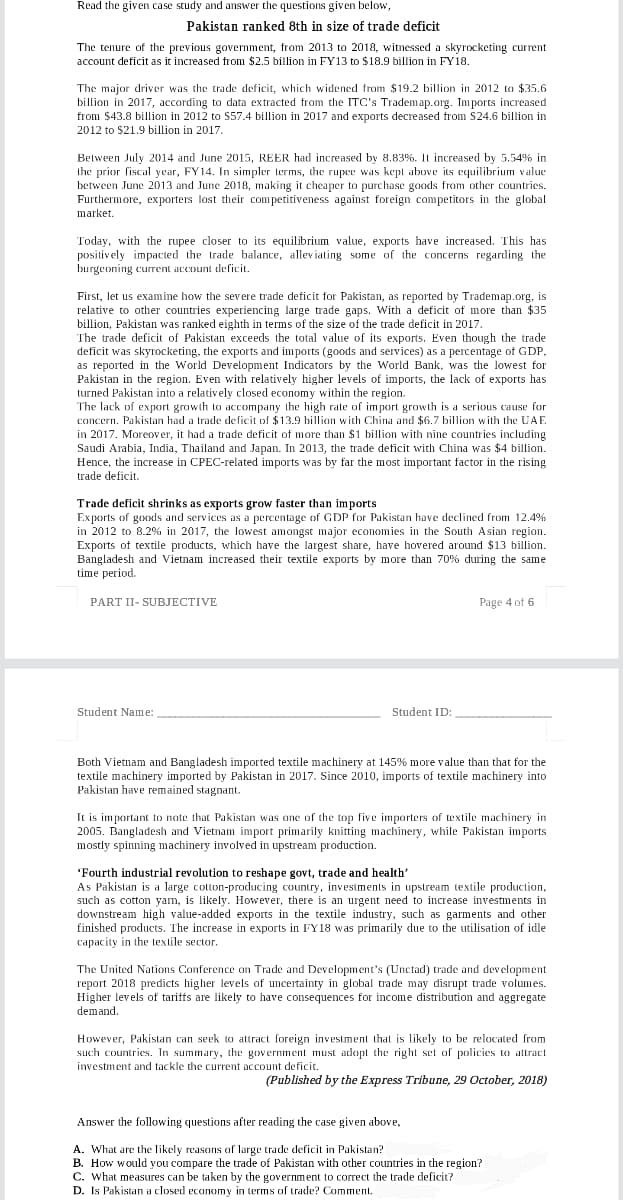Principles of Economics 2e
2nd Edition
ISBN:9781947172364
Author:Steven A. Greenlaw; David Shapiro
Publisher:Steven A. Greenlaw; David Shapiro
Chapter23: The International Trade And Capital Flows
Section: Chapter Questions
Problem 17SCQ: For each of the following, indicate which type of government spending would justify a budget deficit...
Related questions
Question
Please solve only part D of this question

Transcribed Image Text:Read the given case study and answer the questions given below,
Pakistan ranked 8th in size of trade deficit
The tenure of the previous government, from 2013 to 2018, witnessed a skyrocketing current
account deficit as it increased from $2.5 billion in FY13 to $18.9 billion in FY18.
The major driver was the trade deficit, which widened from $19.2 billion in 2012 to $35.6
billion in 2017, according to data extracted from the ITC's Trademap.org. Imports increased
from $43.8 billion in 2012 to S57.4 billion in 2017 and exports decreased from S24.6 billion in
2012 to $21.9 billion in 2017.
Between July 2014 and June 2015, REER had increased by 8.83%. It increased by 5.54% in
the prior fiscal year, FY14. In simpler terms, the rupee was kept above its equilibrium value
between June 2013 and June 2018, making it cheaper to purchase gaods from other countries.
Furthermore, exporters lost their competitiveness against foreign competitors in the global
market.
Today, with the rupee closer to its equilibrium value, exports have increased. This has
positively impacted the trade balance, alleviating some of the concerns regarding the
burgeoning current account deficit.
First, let us examine how the severe trade deficit for Pakistan, as reported by Trademap.org, is
relative to other countries experiencing large trade gaps. With a deficit of more than $35
billion, Pakistan was ranked eighth in terms of the size of the trade deficit in 2017.
The trade deficit of Pakistan exceeds the total value of its exports. Even though the trade
deficit was skyrocketing, the exports and imports (goods and services) as a percentage of GDP,
as reported in the World Development Indicators by the World Bank, was the lowest for
Pakistan in the region. Even with relatively higher levels of imports, the lack of exports has
turned Pakistan into a relatively closed economy within the region.
The lack of export growth to accompany the high rate of import growth is a serious cause for
concern. Pakistan had a trade deficit of $13.9 billion with China and $6.7 billion with the UAE
in 2017. Moreover, it had a trade deficit of more than $1 billiom with nine countries including
Saudi Arabia, India, Thailand and Japan. In 2013, the trade deficit with China was $4 billion.
Hence, the increase in CPEC-related imports was by far the most important factor in the rising
trade deficit.
Trade deficit shrinks as exports grow faster than imports
Exports of goxds and services as a percentage of GDP for Pakistan have declined from 12.4%
in 2012 to 8.2% in 2017, the lowest amongst major economies in the South Asian region.
Exports of textile products, which have the largest share, have hovered around $13 billion.
Bangladesh and Vietnam increased their textile exports by more than 70% during the same
time period.
PART II- SUBJECTIVE
Page 4 of 6
Student Name:
Student ID:
Both Vietnam and Bangladesh imported textile machinery at 145% more value than that for the
textile machinery imported by Pakistan in 2017. Since 2010, imports of textile machinery into
Pakistan have remained stagnant.
It is important to note that Pakistan was one of the top five importers of textile machinery in
2005. Bangladesh and Vietnam import primarily knitting machinery, while Pakistan imports
mostly spinning machinery involved in upstream production.
'Fourth industrial revolution to reshape govt, trade and health'
As Pakistan is a large cotton-producing country, investments in upstream textile production,
such as cotton yam, is likely. However, there is an urgent need to increase investments in
downstream high value-added exports in the textile industry, such as garments and other
finished products. The increase in exports in FY18 was primarily due to the utilisation of idle
capacity in the textile sector.
The United Nations Conference on Trade and Development's (Unctad) trade and development
report 2018 predicts higher levels of uncertainty in global trade may disrupt trade volumes.
Higher levels of tariffs are likely to have consequences for income distribution and aggregate
demand.
However, Pakistan can seek to attract foreign investment that is likely to be relocated from
such countries. In summary, the government must adopt the right set of policies to attract
investment and tackle the current account deficit.
(Published by the Express Tribune, 29 October, 2018)
Answer the following questions after reading the case given above,
A. What are the likely reasons of large trade deficit in Pakistan?
B. How would you compare the trade of Pakistan with other countries in the region?
C. What measures can be taken by the government to correct the trade deficit?
D. Is Pakistan a closed economy in terms of trade? Comment
Expert Solution
This question has been solved!
Explore an expertly crafted, step-by-step solution for a thorough understanding of key concepts.
Step by step
Solved in 2 steps

Knowledge Booster
Learn more about
Need a deep-dive on the concept behind this application? Look no further. Learn more about this topic, economics and related others by exploring similar questions and additional content below.Recommended textbooks for you

Principles of Economics 2e
Economics
ISBN:
9781947172364
Author:
Steven A. Greenlaw; David Shapiro
Publisher:
OpenStax

Principles of Economics 2e
Economics
ISBN:
9781947172364
Author:
Steven A. Greenlaw; David Shapiro
Publisher:
OpenStax